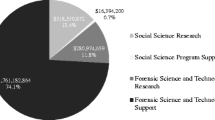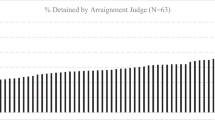Abstract
Quantitative criminology focuses on straightforward causal questions that are ideally addressed with randomized experiments. In practice, however, traditional randomized trials are difficult to implement in the untidy world of criminal justice. Even when randomized trials are implemented, not everyone is treated as intended and some control subjects may obtain experimental services. Treatments may also be more complicated than a simple yes/no coding can capture. This paper argues that the instrumental variables methods (IV) used by economists to solve omitted variables bias problems in observational studies also solve the major statistical problems that arise in imperfect criminological experiments. In general, IV methods estimate causal effects on subjects who comply with a randomly assigned treatment. The use of IV in criminology is illustrated through a re-analysis of the Minneapolis domestic violence experiment. The results point to substantial selection bias in estimates using treatment delivered as the causal variable, and IV estimation generates deterrent effects of arrest that are about one-third larger than the corresponding intention-to-treat effects.
Similar content being viewed by others
References
Abadie, A. (2003). Semiparametric instrumental variable estimation of treatment response models. Journal of Econometrics 113(2), 231–263.
Angrist, J. D. (1990). Lifetime earnings and the Vietnam era draft lottery: Evidence from social security administrative records. American Economic Review 80(3), 313–335.
Angrist, J. D. (2001). Estimation of limited dependent variable models with dummy endogenous regressors: Simple strategies for empirical practice. Journal of Business and Economic Statistics 19(1), 2–16.
Angrist, J. D. & Imbens, G. W. (1995). Two-stage least squares estimates of average causal effects in models with variable treatment intensity. Journal of the American Statistical Association 90(430), 431–442.
Angrist, J. D. & Krueger, A. B. (1999). Empirical strategies in labor economics. In O. Ashenfelter & D. Card (Eds.), Handbook of labor economics, Volume IIIA (pp. 1277–1366). Amsterdam: North-Holland.
Angrist, J. D. & Krueger, A. B. (2001). Instrumental variables and the search for identification. Journal of Economic Perspectives 15(4), 69–86.
Angrist, J. D. & Lavy, V. C. (1999). Using Maimonides' rule to estimate the effect of class size on student achievement. Quarterly Journal of Economics 114(2), 533–575.
Angrist, J. D. & Lavy, V. C. (2002). The effect of high school matriculation awards – Evidence from randomized trials,” NBER Working Paper 9389, December.
Angrist, J. D., Imbens, G. W. & Rubin, D. B. (1996). Identification of causal effects using instrumental variables. Journal of the American Statistical Association 91(434), 444–455.
Berk, R. A. & Sherman, L. W. (1988). Police response to family violence incidents: An analysis of an experimental design with incomplete randomization. Journal of the American Statistical Association 83(401), 70–76.
Berk, R. A. & Sherman, L. W. (1993). Specific Deterrent Effects Of Arrest For Domestic Assault: Minneapolis, 1981–1982 [Computer file]. Conducted by the Police Foundation. 2nd ICPSR ed. Ann Arbor, Michigan: Inter-university Consortium for Political and Social Research [producer and distributor].
Berk, R. A., Smyth, G. K. & Sherman, L. W. (1988). When random assignment fails: Some lessons from the Minneapolis spouse abuse experiment. Journal of Quantitative Criminology 4(3), 209–223.
Bloom, H. S. (1984). Accounting for no-shows in experimental evaluation designs. Evaluation Review 8(2), 225–246.
Boruch, R., De Moya, D. & Snyder, B. (2002). The importance of randomized field trials in education and related areas. In F. Mosteller & R. Boruch (Eds.), Evidence matters: randomized trials in education research. Washington, DC: Brookings Institution.
Campbell, D. T. (1969). Reforms as experiments. American Psychologist 24, 409–429.
Cook, T. D. (2001). Sciencephobia: Why education researchers reject randomized experiments, Education Next http://www.educationnext.org), Fall, 63–68.
Efron, B. & Feldman, D. (1991). Compliance as an explanatory variable in clinical trials. Journal of the American Statistical Association 86(413), 9–17.
Farrington, D. P. (1983). Randomized experiments on crime and justice. In M. H. Tonry & N. Morris (Eds.), Crime and justice. Chicago: University of Chicago Press.
Farrington, D. P. & Welsh, B. C. (2005). Randomized experiments in criminology: What have we learned in the last two decades? Journal of Experimental Criminology 1, 9–38.
Gartin, P. R. (1995). Dealing with design failures in randomized field experiments: Analytic issues regarding the evaluation of treatment effects. Journal of Research in Crime and Delinquency 32(4), 425–445.
Goldberger, A. S. (1991). A course in econometrics. Cambridge, MA: Harvard University Press.
Gottfredson, D. C. (2005). Long-term Effects of Participation in the Baltimore City Drug Treatment Court: Results from an Experimental Study,” University of Maryland, Department of Criminology and Criminal Justice,” mimeo, October 2005.
Holland, P. W. (1986). Statistics and causal inference. Journal of the American Statistical Association 81(396), 945–970.
Imbens, G. W. & Angrist, J. D. (1994). Identification and estimation of local average treatment effects. Econometrica 62(2), 467–475.
Krueger, A. B. (1999). Experimental estimates of education production functions. Quarterly Journal of Economics 114(2), 497–532.
Levitt, S. D. (1997). Using electoral cycles in police hiring to estimate the effects of police on crime. American Economic Review 87(3), 270–290.
McCrary, J. (2002). Using electoral cycles in police hiring to estimate the effects of police on crime: comment. American Economic Review 92(4), 1236–1243.
Permutt, T. & Richard Hebel, J. (1989). Simultaneous-equation estimation in a clinical trial of the effect of smoking on birth weight. Biometrics 45(2), 619–622.
Powers, D. E. & Swinton, S. S. (1984). Effects of self-study for coachable test item types. Journal of Educational Psychology 76(2), 266–278.
Rezmovic, E. L., Cook, T. J. & Douglas Dobson, L. (1981). Beyond random assignment: Factors affecting evaluation integrity. Evaluation Review 5(1), 51–67.
Rossi, P. H., Berk, R. A. & Lenihan, K. J. (1980). Money, work, and crime: Experimental evidence. New York: Academic.
Rubin, D. B. (1974). Estimating causal effects of treatments in randomized and non-randomized studies. Journal of Educational Psychology 66, 688–701.
Rubin, D. B. (1977). Assignment to a treatment group on the basis of a covariate. Journal of Educational Statistics 2, 1–26.
Sherman, L. W. & Berk, R. A. (1984). The specific deterrent effects of arrest for domestic assault. American Sociological Review 49(2), 261–272.
Snow Jones, A. & Gondolf, E. (2002). Assessing the effect of batterer program completion on reassault: An instrumental variables analysis. Journal of Quantitative Criminology 18, 71–98.
Theil, H. (1953). Repeated least squares applied to complete equation systems. The Hague: Central Planning Bureau.
Wald, A. (1940). The fitting of straight lines if both variables are subject to error. Annals of Mathematical Statistics 11, 284–300.
Weisburd, D. L. (2003). Ethical practice and evaluation of interventions in crime and justice: The moral imperative for randomized trials. Evaluation Review 27(3), 336–354.
Weisburd, D. L., Lum, C. & Petrosino, A. (2001). Does research design affect study outcomes in criminal justice? Annals of the American Academy of Political and Social Science 578(6), 50–70.
White, M. J. (2005). Acupuncture in Drug Treatment: Exploring its Role and Impact on Participant Behavior in the Drug Court Setting, John Jay College of Criminal Justice, City University of New York, mimeo.
Woodbury, S. A. & Spiegelman, R. G. (1987). Bonuses to workers and employers to reduce unemployment: Randomized trials in Illinois. American Economic Review 77(4), 513–530.
Wooldridge, J. (2003). Introductory econometrics: A modern approach. Cincinnati, OH: Thomson South-Western.
Author information
Authors and Affiliations
Corresponding author
Rights and permissions
About this article
Cite this article
Angrist, J.D. Instrumental variables methods in experimental criminological research: what, why and how. J Exp Criminol 2, 23–44 (2006). https://doi.org/10.1007/s11292-005-5126-x
Published:
Issue Date:
DOI: https://doi.org/10.1007/s11292-005-5126-x




